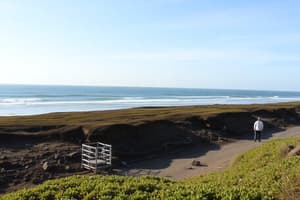Podcast
Questions and Answers
Some people want to conserve the coast, while others want to ______ it.
Some people want to conserve the coast, while others want to ______ it.
develop
Coastal flooding can happen due to ______, tsunamis, and climate change.
Coastal flooding can happen due to ______, tsunamis, and climate change.
storm surges
To reduce flood impacts, people use methods like forecasting and designing buildings to ______ floods.
To reduce flood impacts, people use methods like forecasting and designing buildings to ______ floods.
resist
Soft engineering methods include beach replenishment and ______ of cliffs to make them more stable.
Soft engineering methods include beach replenishment and ______ of cliffs to make them more stable.
Groynes are barriers used in ______ engineering to trap sand along coastlines.
Groynes are barriers used in ______ engineering to trap sand along coastlines.
The coast is constantly changing due to natural processes like erosion, deposition, and ______.
The coast is constantly changing due to natural processes like erosion, deposition, and ______.
Weathering occurs when rocks break down from elements like wind, water, plants, and ______.
Weathering occurs when rocks break down from elements like wind, water, plants, and ______.
The shape and look of the coast depend on the type of rocks, plants, human activities, and changes in ______ level over time.
The shape and look of the coast depend on the type of rocks, plants, human activities, and changes in ______ level over time.
Natural processes like erosion and deposition create features along the coast, including cliffs and wave-cut ______.
Natural processes like erosion and deposition create features along the coast, including cliffs and wave-cut ______.
Coastlines around the world have special ecosystems like coral reefs and ______.
Coastlines around the world have special ecosystems like coral reefs and ______.
Characteristics of a coastal ecosystem include both non-living things like sand and ______.
Characteristics of a coastal ecosystem include both non-living things like sand and ______.
Coastal ecosystems can be damaged by human actions such as building factories and ______ down trees.
Coastal ecosystems can be damaged by human actions such as building factories and ______ down trees.
Different groups often disagree about what’s best for the coast, indicating ______ over how to manage it.
Different groups often disagree about what’s best for the coast, indicating ______ over how to manage it.
Flashcards
Coastal Erosion
Coastal Erosion
The wearing away of land along a coast by natural forces like waves.
Coastal Deposition
Coastal Deposition
The process of dropping or laying down sediment (sand, rocks) carried by waves or other coastal currents.
Headland and Bay
Headland and Bay
A headland is a high point of land jutting out into the sea; a bay is a sheltered area of water.
Coral Reef
Coral Reef
Signup and view all the flashcards
Mangroves
Mangroves
Signup and view all the flashcards
Coastal Management
Coastal Management
Signup and view all the flashcards
Coastal Conflict
Coastal Conflict
Signup and view all the flashcards
Coastal Ecosystem
Coastal Ecosystem
Signup and view all the flashcards
Coastal Flooding
Coastal Flooding
Signup and view all the flashcards
Storm Surge
Storm Surge
Signup and view all the flashcards
Soft Engineering
Soft Engineering
Signup and view all the flashcards
Hard Engineering
Hard Engineering
Signup and view all the flashcards
Shoreline Management Plans
Shoreline Management Plans
Signup and view all the flashcards
Study Notes
Coastal Environments
- Coasts constantly change due to natural processes like waves (erosion, deposition, transport), weathering, and mass movement (landslides, slumping).
- Coastal environments are affected by rock type, nearby plants/trees, and human activities.
- Changes in sea level over time also impact coastal environments.
- Natural processes create various coastal features: headlands, bays, cliffs, wave-cut platforms, caves, arches, stacks, stumps, beaches, spits, and bars.
- Coastlines have unique ecosystems, including coral reefs, sand dunes, salt marshes, and mangroves.
- Coastal ecosystems include living (plants and animals) and non-living (sand, water) components.
- Human activities can damage coastal ecosystems, such as deforestation, building factories, farming, and tourism.
Coastal Management
- Conflicts arise because different groups use coasts for various purposes (conservation vs. development).
- Coastal flooding occurs due to storm surges, tsunamis, and rising sea levels.
- Forecasting, flood-resistant building design, and public education can reduce flooding impacts.
- Coastal protection methods include:
- Soft engineering (beach replenishment, cliff regrading, ecosystem restoration): working with natural processes
- Hard engineering (groynes, revetments, sea walls, gabions, riprap): structural interventions
- Shoreline management plans are crucial for deciding how best to protect specific coastal areas long-term.
Studying That Suits You
Use AI to generate personalized quizzes and flashcards to suit your learning preferences.




